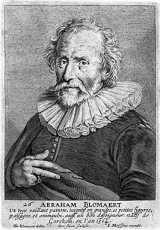Details
Print made by: Jan Saenredam
Published by: Robert de Baudous ;
Engraving
Roethlisberger cites a 'vigorous grisaille drawing of the figure portion in black and white oil color on brown paper, similar in effect to a chiaroscuro' in Dresden.
Hollstein 112
Roethlisberger 56 (under)
Bartsch III.229.29
Additional Information
| SKU | xxab13 |
|---|---|
| Picture Size | 26 x 20 cm |
| Specification | |
| technic | Engraving |
| Artist | Jan Saenredam |
| period | 17th century |
| School | Dutch |
| subject | Mythology |
| rating | **** |
Jan Saenenredam (1565-1607) - Dutch School
Engraver born in Zaandam, c. 1565. Orphaned in childhood, he was raised by an uncle, Pieter de Jongh, a bailiff in Assendelft. Though brought up for a life of farm labour and handiwork, he turned to drawing and in time attained some success as a mapmaker. With the help of a local lawyer, he entered the circle of Hendrick Goltzius relatively late in life, in 1589, and worked for short periods with both Goltzius and Jacques de Gheyn II. Saenredam was one of Goltzius' most important masters and worked closely with him, creating a major body of work. According to both de Bie and Schrevelius, there was some rivalry between each of these masters and Saenredam, who quickly absorbed what they had to offer him. About 1595 Saenredam returned to Assendelft, where he married and where his son Pieter, who later became famous for his paintings of the interiors of churches, was born. He died in Assendelft in 1607.
Inventor
Abraham Bloemaert (1564-1651)
 Painter-Engraver born in Dordrecht. Pupil of amongst other Frans Floris. He went to Paris at a young age and studied the woks of Primatticio and Nicolo dell'Abate. At the age of 19 he was back in Utrecht and worked with Cornelis Van Haarlem. He was influenced by those other Utrecht Mannerists Hendrik Goltzius and Bartholomaus Spranger. His work found birth in Utrecht and Amsterdam and he became one of the most important adepts of the mannerism. Not at least by his long active life and the influence on his sons who worked in the same genius wonderful style.
Painter-Engraver born in Dordrecht. Pupil of amongst other Frans Floris. He went to Paris at a young age and studied the woks of Primatticio and Nicolo dell'Abate. At the age of 19 he was back in Utrecht and worked with Cornelis Van Haarlem. He was influenced by those other Utrecht Mannerists Hendrik Goltzius and Bartholomaus Spranger. His work found birth in Utrecht and Amsterdam and he became one of the most important adepts of the mannerism. Not at least by his long active life and the influence on his sons who worked in the same genius wonderful style.
He excelled more as a colourist than as a draughtsman, was extremely productive, and painted and etched historical and allegorical pictures, landscapes, still-life, animal pictures and flower pieces. In the first decade of the seventeenth-century, Bloemaert began formulating his landscape paintings to include picturesque ruined cottages and other pastoral elements. In these works, the religious or mythological figures play a subordinate role. Country life was to remain Bloemaert's favourite subject, which he depicted with increasing naturalism. He drew motifs such as peasant cottages, dovecotes and trees from life and then on his return to the studio worked them up into complex imaginary scenes
All the items are guaranteed to be originals and as described.
A letter of authenticity is added by simple request.
Items may be returned within 15 days after arrival.
I ship worldwide and provide Insurance and other delivery options.
All items can be purchased instantly at the listed prices,
on reservation of errors in price or availibility..






 Facebook
Facebook Twitter
Twitter Subscribe us
Subscribe us Flickr
Flickr




